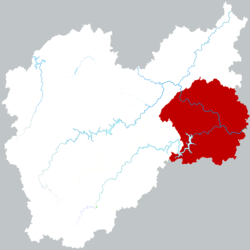Qingtian
青田县 Tsingtien | |
|---|---|
 Hecheng (seat of Qingtian), from the south-east, 2023 | |
| Nickname: Little Europe (小欧洲) | |
 Location of Qingtian County within Lishui | |
| Coordinates: 28°8′3″N 120°17′27″E / 28.13417°N 120.29083°E 28°07′23″N 120°16′59″E / 28.123°N 120.283°E | |
| Country | People's Republic of China |
| Province | Zhejiang |
| Prefecture-level city | Lishui |
| Area | |
• County | 2,493 km2 (963 sq mi) |
| Population (2022) | |
• County | 568,800 |
| • Urban | 168,500 |
| Demonym | Qingtianese |
| Time zone | UTC+8 (China Standard) |
| Postal code | 323900 |
| Area code | 0578 |
| Website | https://www.qingtian.gov.cn/ |
Qingtian (Chinese: 青田; pinyin: Qīngtián; Wade–Giles: Ch'ing-t'ien; lit. 'azure field'), is a county located in the southeastern part of Lishui, Zhejiang, China. It is split in two by the Ou River, which flows 388 kilometers before finally reaching the city of Wenzhou and emptying into the East China Sea. The county has a recorded history since 711 AD, and its name originates from its rich rice paddy fields. It has subtropical monsoon climate, with an annual average temperature of 18.3 °C (64.9 °F), and an annual rainfall of 1,747 mm (68.8 in). It has a hilly territory with many ravines. Its capital is Hecheng, also known as Qingtian City.
The majority of inhabitants speak Qingtianese, while a small minority of residents in Wenxi town (温溪镇) speak Wenzhounese, both of which belong to the larger Wu language family.
The county is particularly famous in China for its diasporan communities spread all across the globe, forming the bulk of Chinese populations in many European states, especially in Spain where they constitute over 80% of the entire Chinese community. The area is also well known by its traditional stonecarving industry, that has been defined as "embroidery on stone" since the Northern and Southern dynasties period at least.[1][2]
- ^ ""Embroidery on stone": Qingtian stone carving in east China". Xinhuanet. 21 November 2020. Retrieved 1 June 2021.
- ^ "Qingtian Stone Carving". chinaculture.org. Retrieved 1 June 2021.
